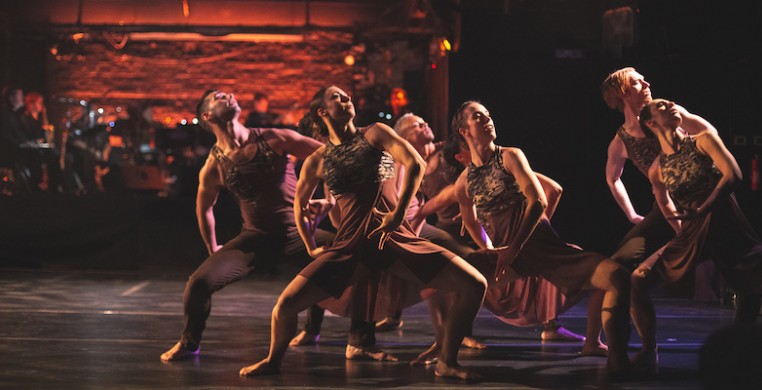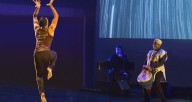Nothing is more charged in the American consciousness today than immigration policy and racial and cultural divides. Cerqua Rivera Dance Theatre (CRDT) winds up its 20th anniversary season with a powerhouse repertory of emotionally-driven works that address these issues in “America/Americans,” running from Sept. 27-Oct. 26 in two alternating concert programs.
The multi-disciplinary company’s mission, “to fuse music, dance, and visual art to explore and celebrate American society,” continues to invigorate new works that tackle compelling social issues through collaboration across the three art forms. “America/Americans” takes the themes of home, cultural identity, and assimilation to new heights with the formal premieres of three works that have been seen in various stages of development through CRDT’s “Inside Out” series.
Program A premieres founding co-artistic directors Wilfredo Rivera and Joe Cerqua’s four-part “American Catracho,” culminating a three-year process of development in a full-length ballet that dives full-force into multi-layered aspects of the immigrant experience. All four sections will be seen for the first time together this season Sept. 27 at Studio 5 Performing Arts Center. “American Catracho” will share the Auditorium Theatre stage with Ensemble Español Spanish Dance Theater on Oct. 4, in the Auditorium’s tribute to Hispanic Heritage Month, and will receive its final fall season performance at the Segundo Ruiz Belvis Cultural Center on Oct. 18.
Program B features Monique Haley’s “Root: mwanzo wa milli ni roho” (translation: “the beginning of the body is spirit”) with original jazz score by Joe Cerqua, and Shannon Alvis’s “Plus: A Place Between Earth and Sky,” with original score by Clarice Assad. Program B takes place Sept. 28 at Studio 5 and Oct. 26 at the Reva and David Logan Center for the Arts.
Wilfredo Rivera came to the U.S. from his native Honduras as a 12-year-old so that he could pursue professional dance studies. “American Catracho” (slang for “gringo”) began as an expression of his immigrant experience, but has expanded from the personal to the universal in a sweeping exploration of displacement, dangerous crossings and discrimination throughout the history of immigration, not just in America, but globally as well.
Over the past three years, Rivera and his collaborators have conducted extensive research to inform the loose narrative that frames the four sections of “Catracho.” Noelle Kayser and Christian Denice contributed supplemental choreography, while painter Lewis Achenbach created a visual landscape. Close collaboration with well-known Chicago theatre director Cecilie Keenan has informed Rivera’s process with theatrical perspective, and Dr. Daniel Michaud-Novak provided valuable insight into the psychological trauma many immigrants have experienced. Joe Cerqua’s score includes Honduran folk elements, as well as Eastern and Indian influences, employing evocative vocalizations and sound cues to create different environments.
Case histories of immigrants suffering from PTSD, personal interviews, poetry from around the world, and historic newspaper and magazine archives expressing anti-immigration sentiment dating back to the 1700’s figure into Rivera’s libretto. He was astounded to find the same rhetoric of fear and loathing of immigrants that we hear from certain political corners today, expressed in quotes from 17th and 18th-century politicians, clergy and civic leaders. There was even an outspoken black abolitionist who protested allowing immigrants into the country for fear they would usurp employment opportunities.
Documentary footage depicting points of entry and modes of transport were of particular interest to Rivera, some immigrants even swimming, latching onto moving trains, walking across deserts and through dense forest, or hiding in trucks for days. The social, political and economic aspects of immigration are all tied to the despair and anxiety that accompanies many immigrants’ desperate attempts to escape the physical violence of their homelands, risking their lives to come to America. Rivera knows first hand the arduous struggle his own parents experienced escaping Honduras, and the mammoth legal battle they fought with his help to gain entry. In the end, “American Catracho” is optimistic, looking through the lens of loss toward the possibilities of new beginnings.
“Root” has evolved over a two-year period. Inspired by Hayley’s life and heritage, she collaborated with Cerqua to investigate the relationship of the body and spirit in dance and to explore the modern African/American experience through traditional African modes. She was initially inspired by a collection of African maxims in “African Cultural Values: An Introduction,” by Kwame Gyeke. In an excerpt of the piece performed this past August as part of Summerdance Festival at the Pritzker Pavillion, an on-stage drummer in African dress interacted with the dancers. Hayley’s movement paralleled the percussive accents of the music with sudden, thrusting arm gestures, hand flicks and trembling, a range that sought its extreme limits in split-leg extensions and fierce assertiveness. The blend of ballet, jazz and African forms evoked the melding of cultures in contemporary African American life.
“Plus: A Place Between Earth and Sky” explores choreographer Alvis’s long-hidden Native American heritage and is inspired by a Blackfoot legend that looks at our role in the world around us.
--
Cerqua Rivera Dance Theatre's fall tour runs Sept. 27-Oct. 26 at various venues. Tickets are $7-$100, available by clicking the event pages below.


